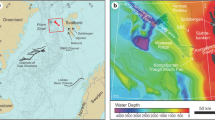Abstract
The Delgada Fan, an irregularly shaped turbidite deposit extending more than 350 km offshore from northern California, consists of two large leveed-valley units each fed by a separate complex of coalescing submarine canyons and slope gullies. Although the leveed-valley units head within 25 km of each other, both appear to have developed independently during fan growth. The larger southern leveed-valley system has not developed middle-fan distributary channels and appears to illustrate a period of progressive valley abandonment. Although the lower-fan area is underlain by sandy sediments, little sand has been recovered in piston cores from the leveed-valley unit.
Similar content being viewed by others
References
McManus, D. A., and others, 1970. Site 32. In: D. A. McManus and others, Initial Reports of the Deep Sea Drilling Project, v. 5. U.S. Government Printing Office, Washington, DC, pp. 15–56.
Atwater, T., 1970. Implications of plate tectonics for the Cenozoic tectonic evolution of western North America. Geological Society of America Bulletin, v. 81, pp. 3513–3536.
Menard, H. W., 1960. Possible pre-Pleistocene deep-sea fans off central California. Geological Society of America Bulletin, v. 71, pp. 1271–1278.
Wilde, P., Normark, W. R., and Chase, T. E., 1976. Oceanographic data off Central California, 37° to 40° North including the Delgada deep-sea fan. Lawrence Berkeley Laboratory Publication No. 92, Berkeley, CA.
Hamilton, E. L., 1967. Marine geology of abyssal plains in the Gulf of Alaska. Journal of Geophysical Research, v. 72, pp. 4189–4213.
Normark, W. R., 1970. Growth patterns of deep-sea fans. American Association of Petroleum Geologists Bulletin, v. 54, pp. 2170–2195.
Normark, W. R., 1978. Fan valleys, channels, and depositional lobes on modern submarine fans: characters for recognition of sandy turbidite environments. American Association of Petroleum Geologists Bulletin, v. 62, pp. 912–931.
Damuth, J. E., 1975. Echo character of the western equatorial Atlantic floor and its relationship to the dispersal and distribution of terrigenous sediments. Marine Geology, v. 18, pp. 17–45.
Normark, W. R., Piper, D. J. W., and Hess, G. R., 1979. Distributary channels, sand lobes, and mesotopography of Navy Submarine Fan, California Borderland, with applications to ancient fan sediments. Sedimentology, v. 26, pp. 749–774.
Author information
Authors and Affiliations
Rights and permissions
About this article
Cite this article
Normark, W.R., Gutmacher, C.E. Delgada Fan: Preliminary interpretation of channel development. Geo-Marine Letters 3, 79–83 (1983). https://doi.org/10.1007/BF02462451
Received:
Revised:
Issue Date:
DOI: https://doi.org/10.1007/BF02462451




